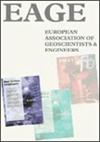Electrical resistivity tomography through reinforced concrete floor
IF 1.6
4区 地球科学
Q3 GEOCHEMISTRY & GEOPHYSICS
引用次数: 0
Abstract
The electrical resistivity tomography (ERT) method is often challenged by the presence of reinforced concrete (RC) in urban and industrial environments, because the embedded metallic wire mesh can severely distort the distribution of subsurface currents. We investigate one typical scenario in real applications, in which an RC floor overlays the natural topsoil or rock. Our synthetic forward simulations show that the embedded wire mesh behaves like a local good conductor in data of small source-receiver separations and acts like an equal-potential object that keeps the potential from decaying at large source-receiver separations. Routine ERT inversions that ignore the RC cannot work properly because the thin and highly conductive wire mesh may be manifested as large uninterpretable low-resistivity anomalies in the imaging results. Two remedies are adopted to improve the ERT resolution in such cases. First, we find a top layer with high conductivity in our model to adequately represent the wire mesh; then, we initiate the inversion with the top-layer model as the starting and reference model. This warm-start approach overcomes the difficulty of recovering the large conductivity contrast between metallic objects and regular earth materials. Second, underground electrodes are added to the survey array, so more information from depth can be obtained to fight against the dominance of current channelling in the wire mesh. Finally, our strategies are used to invert a real ERT dataset from an indoor manufacturing plant, where RC covers the entire floor of the building and electrodes are in contact with the soil through open holes in the floor. Our simulation and field data inversion verify our findings and demonstrate the effectiveness of our solutions in improving the resolution of ERT when the survey is carried out over RC floor in urban and industrial environments.钢筋混凝土地面电阻率层析成像
电阻率层析成像(ERT)方法经常受到城市和工业环境中钢筋混凝土(RC)存在的挑战,因为嵌入的金属丝网会严重扭曲地下电流的分布。我们研究了实际应用中的一个典型场景,即RC地板覆盖在天然表土或岩石上。我们的综合正演模拟表明,在小的源接收机距离数据中,嵌入式金属丝网表现得像一个局部的良好导体,而在大的源接收机距离数据中,它表现得像一个等电位物体,防止电位衰减。忽略RC的常规ERT反演无法正常工作,因为细而高导电性的钢丝网可能在成像结果中表现为无法解释的大的低电阻率异常。在这种情况下,采用两种补救措施来改善ERT决议。首先,我们在模型中找到一个具有高导电性的顶层,以充分代表金属丝网;然后,以顶层模型作为起始模型和参考模型启动反演。这种热启动方法克服了恢复金属物体和常规地球材料之间大电导率对比的困难。其次,将地下电极添加到测量阵列中,因此可以从深度获得更多信息,以对抗导线网中电流通道的主导地位。最后,我们的策略用于反演来自室内制造工厂的真实ERT数据集,其中RC覆盖了建筑物的整个楼层,电极通过地板上的开孔与土壤接触。我们的模拟和现场数据反演验证了我们的发现,并证明了我们的解决方案在提高ERT分辨率方面的有效性,当在城市和工业环境中对RC地板进行调查时。
本文章由计算机程序翻译,如有差异,请以英文原文为准。
求助全文
约1分钟内获得全文
求助全文
来源期刊

Near Surface Geophysics
地学-地球化学与地球物理
CiteScore
3.60
自引率
12.50%
发文量
42
审稿时长
6-12 weeks
期刊介绍:
Near Surface Geophysics is an international journal for the publication of research and development in geophysics applied to near surface. It places emphasis on geological, hydrogeological, geotechnical, environmental, engineering, mining, archaeological, agricultural and other applications of geophysics as well as physical soil and rock properties. Geophysical and geoscientific case histories with innovative use of geophysical techniques are welcome, which may include improvements on instrumentation, measurements, data acquisition and processing, modelling, inversion, interpretation, project management and multidisciplinary use. The papers should also be understandable to those who use geophysical data but are not necessarily geophysicists.
 求助内容:
求助内容: 应助结果提醒方式:
应助结果提醒方式:


